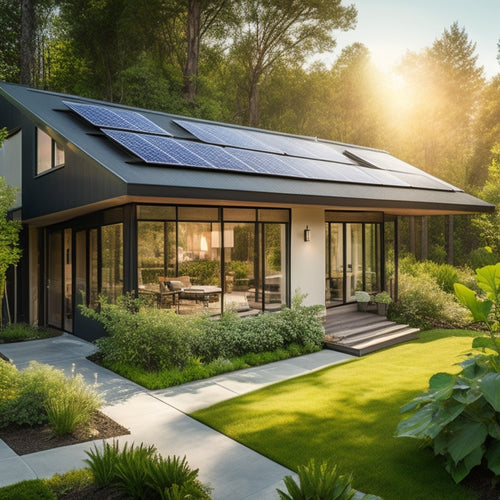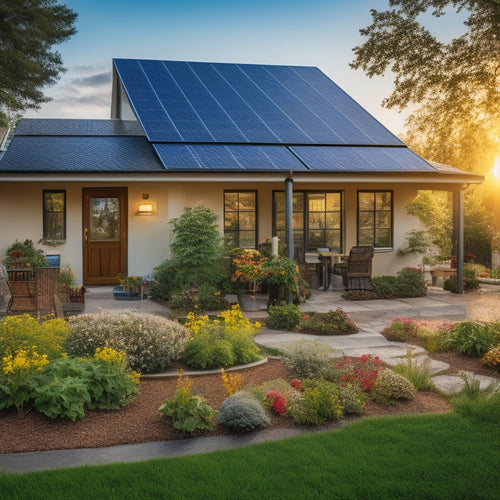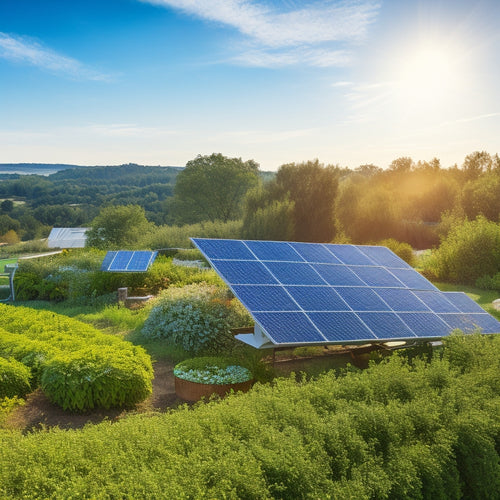
Estimating Your Solar Panel Needs in 7 Steps
Share
To estimate your solar panel needs, you'll need to calculate your daily energy consumption in watt-hours, evaluating high-energy appliances and reviewing past utility bills. Next, consider your roof's condition, taking into account age, size, orientation, and materials. Choose a solar panel type based on efficiency, cost, and aesthetics. Then, size your system based on energy requirements, panel efficiency, and local building codes. Don't forget to research local regulations, certifications, and budget constraints, including financing options and energy savings. By following these steps, you'll be well on your way to determining the right solar panel system for your needs, and understanding the subtleties that will make it a success.
Key Takeaways
- Calculate daily energy consumption in watt-hours (Wh) to determine accurate solar panel needs.
- Assess your roof's condition, size, orientation, and material for optimal solar panel placement.
- Choose the right solar panel type based on efficiency, cost, and aesthetic preferences.
- Size your solar panel system according to your energy requirements, panel efficiency, and local building codes.
- Consider budget constraints, financing options, and government incentives to make solar panels affordable.
Determine Your Energy Usage
To determine your energy usage, you'll need to calculate your daily energy consumption in watt-hours (Wh). This will give you an accurate estimate of how much energy you need to generate from solar panels.
Start by identifying the appliances and devices that consume the most energy in your home, such as refrigerators, air conditioners, and lighting systems. Then, check the labels or manuals to find their power ratings in watts (W). Multiply the power rating by the number of hours you use each device daily to get the total daily energy consumption in Wh.
Focus on energy efficiency by reducing your energy usage through simple changes like switching to LED bulbs, using power strips, and adjusting your thermostat. This won't only reduce your carbon footprint but also lower your energy bills.
Assess Your Roof's Condition
You'll need to evaluate your roof's condition to guarantee it can support solar panels.
The age of your roof is a critical factor, as older roofs may require replacement before installation, adding to the overall cost.
Additionally, you'll need to take into account the size of your roof, as it will impact the number of panels you can install and the system's overall efficiency.
Roof Age Matters
The age of your roof plays a critical role in determining the feasibility of a solar panel installation. As you assess your roof's condition, consider its age and how it affects its overall integrity. An older roof may require more maintenance, repairs, or even replacement, which can impact the installation process and overall cost.
You should also examine your roof's materials, orientation, and pitch to ascertain they're compatible with solar panels. For instance, a roof with a southern orientation and a pitch between 15 and 40 degrees is ideal for solar panels.
Additionally, consider the roof's insulation, as this can affect the temperature and energy efficiency of your home.
Check your roof's warranties and maintenance records to identify any potential issues. If you've recently replaced your roof or have a warranty in place, it may be more feasible to install solar panels.
Conversely, if your roof requires frequent repairs or is nearing the end of its lifespan, it may be more cost-effective to replace it before installing solar panels.
Roof Size Importance
Space and capacity are vital considerations when evaluating your roof's condition for solar panel installation. You need to assess the available roof space to determine how many solar panels you can fit, which directly impacts the overall energy output. A larger roof provides more space for solar panels, but it's not just about the size – the roof orientation also plays a significant role. A south-facing roof receives the most sunlight, making it ideal for solar panels. An east- or west-facing roof can still work, but you'll need to adjust the panel angle and layout accordingly.
Conduct a shading analysis to identify any obstacles that might cast shade on your roof, such as trees, chimneys, or neighboring buildings. This will help you determine the best placement for your solar panels.
Additionally, consider the roof's dimensions and shape to guarantee the solar panels fit comfortably and don't interfere with other roof features, like skylights or vents.
Calculate Your Energy Goals
You need to understand your energy usage patterns to determine how much electricity you want your solar panel system to generate.
To do this, calculate your daily energy consumption in watt-hours (Wh) or kilowatt-hours (kWh) by reviewing your past utility bills or using an energy monitoring device.
This information will help you set realistic energy goals for your solar panel system.
Energy Usage Patterns
Calculating your energy goals involves understanding your energy usage patterns, which serve as the foundation for determining how many solar panels you'll need to offset your energy consumption.
To do this, you'll need to assess your energy usage habits and identify areas where you can improve energy efficiency. Start by gathering your past utility bills to get a sense of your average energy usage.
Analyze your bills to determine when you use the most energy - is it during the day when you're at home, or at night when you're running appliances? Identify any energy-intensive appliances or systems, such as pool pumps or HVAC systems, that could be optimized for energy efficiency.
You should also consider your energy usage patterns during peak seasons, such as summer or winter, when energy consumption tends to be higher.
Daily Energy Consumption
By understanding your daily energy consumption patterns, you'll be able to calculate your energy goals and determine the right size solar panel system for your needs. To do this, you'll need to track your daily energy usage in kilowatt-hours (kWh).
Start by identifying your power sources, including lights, appliances, and electronics, and their corresponding wattage ratings. Next, estimate the number of hours each device is used daily. Multiply the wattage by the hours used to get the daily energy consumption in watt-hours (Wh). Convert this to kWh by dividing by 1,000.
Add up the daily energy consumption of all devices to get your total daily energy needs. Consider energy efficiency measures you've implemented, such as LED lighting or energy-efficient appliances, as these can reduce your overall energy requirements.
Be sure to account for any seasonal variations in energy usage, such as increased heating or cooling needs during winter or summer months. With an accurate estimate of your daily energy consumption, you can set realistic energy goals and choose a solar panel system that meets your power needs.
Choose Your Solar Panel Type
Solar panels come in various types, each with its unique characteristics, advantages, and disadvantages. You'll need to evaluate these factors to choose the right type for your needs.
Monocrystalline panels offer high solar efficiency ratings (15-20%) and are ideal for small spaces, but they're more expensive. Polycrystalline panels, on the other hand, have lower efficiency ratings (12-15%) but are more affordable. Thin film panels are flexible and lightweight, making them perfect for unusual roof shapes or sizes. However, they've lower efficiency ratings (7-14%) and occupy more space.
When selecting a panel type, assess installation costs, environmental impact, and aesthetic considerations. Monocrystalline panels have a sleeker appearance, while polycrystalline panels have a blue hue. Thin film panels are often black or dark blue.
Look for warranty options, too, as they vary between manufacturers. Ultimately, evaluating the benefits and drawbacks of each type will help you make an informed decision. By choosing the right panel type, you'll maximize your energy production and reduce your environmental footprint.
Consider Local Building Codes
As you prepare to install your solar panel system, it's vital to take into account the local building codes and regulations in your area. These codes vary by region, so it's important to research and understand the specific requirements that apply to your project.
| Regulation | Description |
|---|---|
| Local Regulations | Zoning laws, environmental impact, and utility regulations that govern solar panel installations |
| Permit Requirements | Necessary permits and licenses required for installation, connection, and operation |
| Installation Guidelines | Safety standards, electrical codes, and structural requirements for a safe and compliant installation |
| Code Compliance | Making sure your system meets local building codes, including inspections and certifications |
Failing to comply with local regulations can result in fines, penalties, or even system shutdown. Take the time to research and understand the specific regulations in your area to guarantee a smooth and successful installation. Remember, compliance is key to a safe and efficient solar panel system.
Evaluate Your Budget Constraints
Once you've verified your solar panel system complies with local building codes, it's essential to evaluate your budget constraints to determine the size and type of system you can afford.
This step is vital in guaranteeing you invest in a system that meets your energy needs without breaking the bank.
When evaluating your budget, consider the following key factors:
-
System cost: The upfront cost of purchasing and installing your solar panel system.
-
Financing options: Investigate available financing options, such as loans or power purchase agreements, to determine which one works best for you.
-
Incentive programs: Research and take advantage of available government incentives, such as tax credits, to reduce your upfront costs.
- Ongoing expenses: Calculate your expected energy savings and ongoing maintenance costs to make certain your system remains affordable in the long run.
Size Your Solar Panel System
How much power do you need to generate to meet your energy demands? To determine the ideal solar panel system size, you'll need to calculate your total energy requirements.
Consider your daily energy usage in kilowatt-hours (kWh), bearing in mind your appliances, lighting, and HVAC systems. You can find this information on your past utility bills.
Next, factor in the solar panel efficiency, which ranges from 15% to 20%. Higher-efficiency panels produce more power per unit area, but are also more expensive.
Consider your installation orientation and angle, as well. Best orientation is typically south-facing, with an angle equal to your latitude.
Using an online solar panel calculator or consulting with a professional, input your energy requirements, panel efficiency, and installation details to determine the required system size.
This will give you the total wattage needed to meet your energy demands. Keep in mind that it's better to oversize your system slightly to account for variables like weather and seasonal changes.
Frequently Asked Questions
Can I Install Solar Panels on a Metal or Tile Roof?
You can install solar panels on a metal roof, but guarantee the metal roof installation meets structural integrity requirements. For tile roof considerations, you'll need to remove and replace tiles, adding complexity and cost to the installation process.
Will Solar Panels Increase My Property Value?
You'll be pleased to know that solar panels can enhance your property value, as a savvy solar investment. In fact, a property appraisal will likely reflect the increased worth, thanks to the eco-friendly upgrade, potentially adding thousands to your property's resale value.
Do Solar Panels Work During a Power Outage?
You'll be relieved to know that solar panels can work during a power outage, but only if you have a battery storage system to store excess energy, ensuring ideal solar panel efficiency and a reliable power supply.
Are Solar Panels Resistant to Hail and Extreme Weather?
You'll be relieved to know that solar panels are built to withstand hail damage and extreme weather conditions, boasting impressive weather durability through sturdy construction and rigorous testing, ensuring your power stays on even in harsh environments.
Can I Claim Solar Panel Installation Costs on My Taxes?
As you shine a light on your solar panel installation, you'll uncover a pot of gold: tax incentives and installation rebates that'll make your investment sparkle. You can claim 26% of your costs on your taxes, illuminating a brighter financial future.
Conclusion
You've traversed the 7-step expedition to estimate your solar panel needs! Now, as you stand at the threshold of utilizing renewable energy, imagine the satisfaction of being a modern-day pioneer, illuminating your path with clean power. With a clear understanding of your energy requirements, roof conditions, and budget constraints, you're ready to size your solar panel system. It's time to flip the switch and let the sunshine in – your wallet, the environment, and your conscience will thank you.
Related Posts
-

Integrating Solar Panels Into Home Design
Integrating solar panels into your home design greatly enhances energy efficiency and lowers utility bills while addi...
-

How to Achieve Energy Independence at Home
To achieve energy independence at home, start by investing in renewable energy sources like solar panels, wind turbin...
-

Green Energy Alternatives for Independent Living
To enhance your independent living, consider green energy alternatives like solar panels and wind turbines. These opt...


